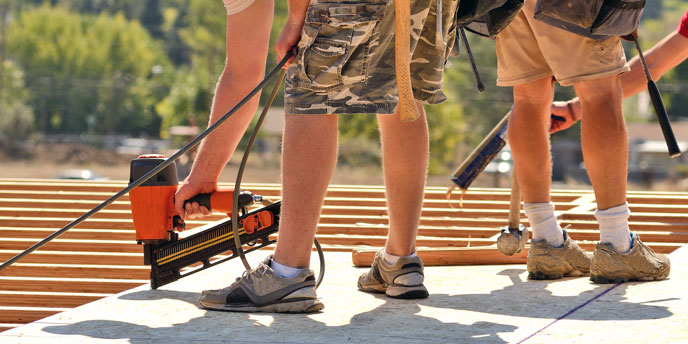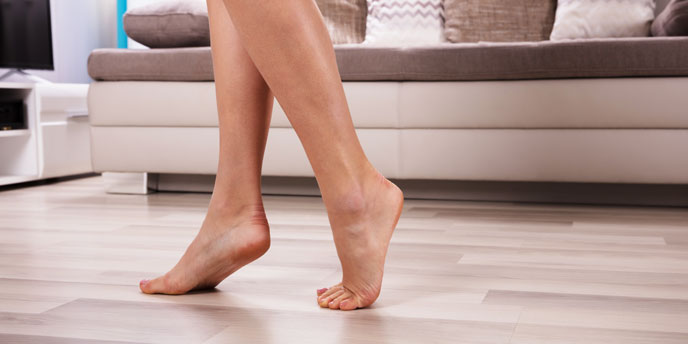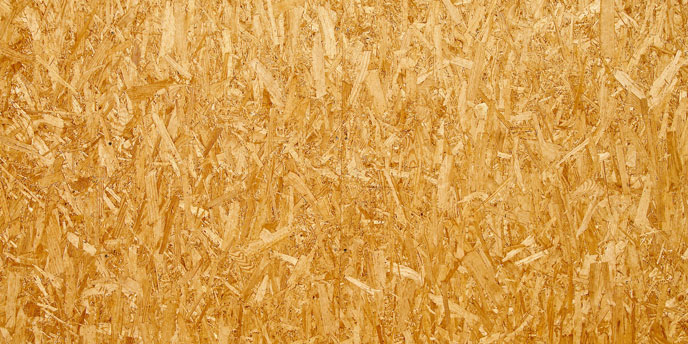How To Repair Soft Spot In Subfloor
How to Tell When Information technology'southward Fourth dimension to Replace Your Subfloor
12
Maybe you noticed a soft spot under the carpet. Or maybe your floorboards are squeaking a little louder than usual. Either way, you're left wondering: "is it fourth dimension to replace my subfloor?" Subfloor damage is typically caused by overexposure to wet. This could be from excessive humidity, a leak in your plumbing or a crack in your home's outside. While the thought of replacing it might give you lot a sinking feeling – literally – knowing when it's time to replace your subfloor will allow you lot to head off more serious bug. An OSB subfloor existence installed over floor joists. A subfloor acts as a buffer between the joists and the finished flooring. A subfloor is the solid textile beneath your floor roofing. It is attached to your home's floor joists and acts equally a base for your finished flooring, such equally carpet, hardwood, laminate, tile, etc. Typically, a subfloor is made of plywood or oriented strand lath (OSB) panels. In areas that are below grade, such as a basement, the concrete foundation is often considered the subfloor, though plywood and OSB panels tin can exist installed over concrete using ground-level floor joists called sleepers. It depends. Higher up grade, hardwood, carpet, laminate and other floor coverings demand a plywood or OSB panel subfloor, as they cannot be installed directly to floor joists. Below grade, a plywood or OSB subfloor is optional, depending on your pick of flooring. Floating laminate, engineered hardwood, tile and rug can be installed straight on a concrete subfloor if the proper wet barriers are in place. If you notice a soft spot under carpet or wood flooring, it could mean that the panels beneath take weakened. While replacing the entire subfloor may not be necessary, you will have to replace the damaged pieces to prevent the rot from spreading. Subfloors squeak when the nails connecting them to the joists are pulled loose. Equally you walk across the floor, the nails move in and out of the wooden joists, causing the awful, familiar audio of creaky floorboards. If you notice squeaking throughout the entire room, this could exist a sign that the material has warped. The smell of mold or mildew is a surefire sign of water damage, only the tricky role is finding where. If your carpet or wood floor smells musty, yous almost certainly are dealing with a water damaged subfloor. Kenton Shepard | Manager of Greenish Building, InterNACHI In that location's zippo wrong with having a little leap in your stride – unless that springy feeling comes from the flooring. If your floors brainstorm to feel spongy, springy or bouncy, or if you observe the floorboards around y'all shifting when you walk on them, it could mean that it's time to replace the subfloor. "A toilet moves because the subfloor has become so decayed that it no longer securely anchors the fasteners that concord it to the floor," says Shepard. Often, the moisture damage is from a slow leak in your toilet's pipes. Since it will only worsen with time, it's important to go it fixed ASAP. Kenton Shepard | Director of Light-green Building, InterNACHI Considering tile is inflexible, it requires a potent, rigid surface beneath it to prevent it from cracking. If you lot discover cracks in your tile flooring, it may mean the subfloor isn't business firm enough to hold it up and will need replacing. Go on in mind that when installing tile over plywood or OSB, there must be a cement backerboard between the tile and the panels. While it could mean your home's humidity is likewise high, hardwood flooring cupping could also exist a sign that water is warping the materials beneath. Just fright not – you can contrary cupping with the assistance of professional hardwood drying services, equally long as the source of moisture has been addressed. While bubbling linoleum isn't always a cause for business organization, it tin exist if it'south caused by wet building up under your flooring. If there are irregularities throughout your linoleum flooring, y'all may need to await a piffling harder to rule out water damage to your subfloor. To be clear, a leaking ceiling is not your subfloor's mistake. Simply it may exist an indication that your home has a slow leak. Since plywood and OSB tend to absorb moisture, by the time h2o has leaked through the ceiling, it could mean the materials are completely soaked through. In addition to calling the plumber, yous may want to call a floor professional to check for subfloor damage. "A subfloor's lifespan depends mostly on the materials used and the amount of moisture they're exposed to," says Shepard. "Fairly protected from wet, nigh subfloor materials tin can be expected to final for the lifespan of the dwelling." However, if the subfloor is consistently exposed to moisture, you may need to supplant it after 20 to 30 years or sooner. Subfloor damage caused by h2o can be reversed with the help of professional person tools, but it'southward of import to catch the signs of rot early to prevent it from spreading to the rest of your subflooring materials. The cost to replace a subfloor tin vary based on a number of factors including the quality, blazon and thickness of your subfloor fabric, as well as the boosted work required (removing and disposing of the old materials, repairing joists or other flooring features, etc.). On average, replacing an entire subfloor in a 300-square-pes room tin can cost between $450 – $2,000. Note that this does not account for the cost of replacing the finished flooring. Professional subfloor replacements in kitchens and bathrooms may price more than than standard estimates. This is because the contractors may have to motion appliances or fixtures to finish the installation. If you've decided it'south time to replace your subfloor, make sure to fix the source of your subfloor impairment too. Without addressing the root cause of the damage, you lot'll eventually need to supercede your entire subfloor all again. Be sure to bank check nearby pipes, exterior vents and appliances for leaks, and have a disposal plan for any h2o-damaged materials you come up across. While replacing your subfloor may not exist an HGTV-worthy project, information technology'due south an of import one to protect your abode from further damage, and can save yous from even more costly repairs down the line. Plus, it might only be the perfect excuse to install that beautiful hardwood floor you've had your center on. Stay ahead of more than just subfloor damage with our preventative abode maintenance posts: 
What Is a Subfloor?
Do I Need a Subfloor?
9 Common Signs of Subfloor Damage

ane. Your floors are uneven or sunken in parts.
2. Your floorboards squeak – loudly.
3. The room smells musty.
What are the most common causes of subfloor damage?
 "By far the most common crusade of subfloor damage is moisture. Mutual sources are plumbing fixtures, especially toilets and tubs-with-showers, but too whatever areas with sinks or appliances that are likely to leak, including bathrooms, kitchens, and laundry rooms. Other less mutual causes are burn and impact."
"By far the most common crusade of subfloor damage is moisture. Mutual sources are plumbing fixtures, especially toilets and tubs-with-showers, but too whatever areas with sinks or appliances that are likely to leak, including bathrooms, kitchens, and laundry rooms. Other less mutual causes are burn and impact."
4. Your floors shift or bounce when y'all walk on them.
v. Your toilet is rocking or loose.
What are another areas that are prone to subfloor damage?
 "Outside doors that are poorly installed tin can fail to protect subfloors from pelting and snow, and information technology's not unusual to find decay in these areas when inspecting crawlspaces and basements. Especially in warmer climates, crawlspaces that feel seasonal flooding can enhance relative humidity to a level at which particle lath tin can experience some deterioration."
"Outside doors that are poorly installed tin can fail to protect subfloors from pelting and snow, and information technology's not unusual to find decay in these areas when inspecting crawlspaces and basements. Especially in warmer climates, crawlspaces that feel seasonal flooding can enhance relative humidity to a level at which particle lath tin can experience some deterioration."
vi. Your tile flooring has cracked.
7. Your hardwood floor is cupping.
8. Your linoleum floor is bubbling up.
9. Your ceiling is leaking.

How Long Does a Subfloor Last?
How Much Does It Price to Supercede a Subfloor?
Average Cost to Supervene upon a Subfloor
(300 sq. ft)
Detail DIY Professional Materials $483 $483 Labor $0 $175 Total $483 $658 When Repairing Damaged Subfloors, Always Find the Source
How To Repair Soft Spot In Subfloor,
Source: https://www.budgetdumpster.com/blog/when-to-replace-subfloor/
Posted by: cooksioned69.blogspot.com


0 Response to "How To Repair Soft Spot In Subfloor"
Post a Comment